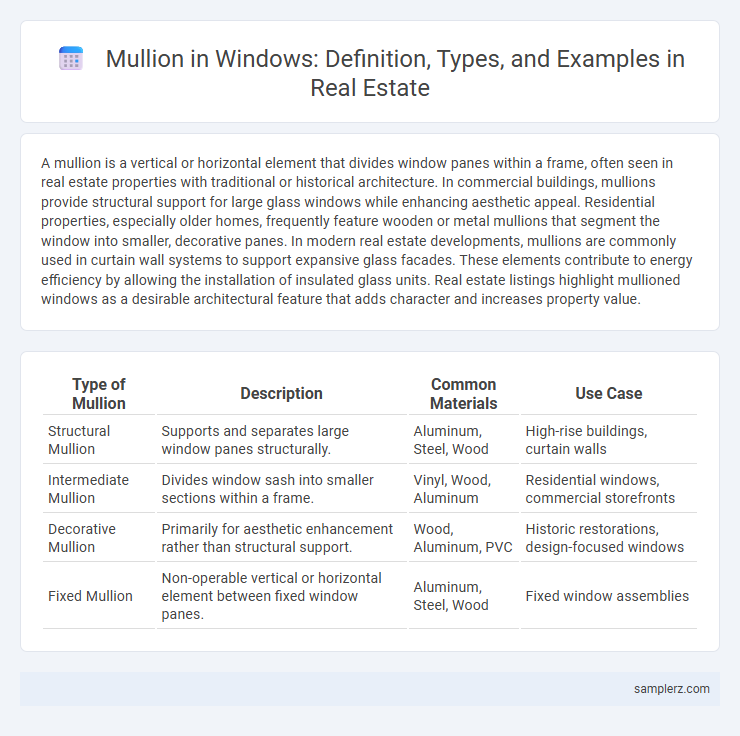A mullion is a vertical or horizontal element that divides window panes within a frame, often seen in real estate properties with traditional or historical architecture. In commercial buildings, mullions provide structural support for large glass windows while enhancing aesthetic appeal. Residential properties, especially older homes, frequently feature wooden or metal mullions that segment the window into smaller, decorative panes. In modern real estate developments, mullions are commonly used in curtain wall systems to support expansive glass facades. These elements contribute to energy efficiency by allowing the installation of insulated glass units. Real estate listings highlight mullioned windows as a desirable architectural feature that adds character and increases property value.
Table of Comparison
| Type of Mullion | Description | Common Materials | Use Case |
|---|---|---|---|
| Structural Mullion | Supports and separates large window panes structurally. | Aluminum, Steel, Wood | High-rise buildings, curtain walls |
| Intermediate Mullion | Divides window sash into smaller sections within a frame. | Vinyl, Wood, Aluminum | Residential windows, commercial storefronts |
| Decorative Mullion | Primarily for aesthetic enhancement rather than structural support. | Wood, Aluminum, PVC | Historic restorations, design-focused windows |
| Fixed Mullion | Non-operable vertical or horizontal element between fixed window panes. | Aluminum, Steel, Wood | Fixed window assemblies |
Definition of Mullion in Window Design
A mullion in window design is a vertical or horizontal element that divides and supports adjacent window panes, enhancing both structural stability and aesthetic appeal. Typically constructed from materials such as wood, aluminum, or steel, mullions create distinct sections within a window frame, allowing for varied glass configurations and improved load distribution. Incorporating mullions enables architects to balance natural light penetration with architectural style, contributing to energy efficiency and design versatility in real estate properties.
Historical Uses of Mullions in Architecture
Mullions, vertical or horizontal bars dividing window panes, have been integral to Gothic and Tudor architecture for centuries, enhancing both structural stability and aesthetic appeal. Historic buildings such as medieval cathedrals and Elizabethan manor houses prominently feature stone or wooden mullions that support large stained glass windows. These architectural elements allowed for increased window size while maintaining the strength of walls, contributing to the iconic look of various historic European structures.
Common Materials for Window Mullions
Window mullions are commonly crafted from materials such as wood, aluminum, and vinyl, each offering unique benefits in terms of durability and aesthetics. Wood provides a traditional, natural look with excellent insulation but requires regular maintenance, while aluminum offers strength and resistance to weathering with minimal upkeep. Vinyl mullions are cost-effective and energy-efficient, making them popular in modern residential construction.
Classic Mullion Window Styles in Homes
Classic mullion window styles in homes often feature vertical and horizontal bars dividing the glass panes, enhancing both structural integrity and aesthetic appeal. These mullions are commonly found in traditional architectural designs such as Colonial, Tudor, and Victorian homes, where they create a timeless grid pattern that complements the overall facade. Incorporating wood or aluminum mullions, these windows provide character while allowing natural light to flow through multiple smaller sections of glass.
Modern Mullion Applications in Contemporary Properties
Modern mullion applications in contemporary properties enhance window design by integrating sleek, narrow aluminum profiles that support expansive glass panels, maximizing natural light while maintaining structural integrity. These mullions often incorporate thermal breaks and weatherproofing elements, improving energy efficiency and durability in high-performance facades. Innovative designs combine functionality with aesthetic appeal, contributing to minimalist architectural trends in commercial and residential buildings.
Functional Benefits of Mullions in Windows
Mullions in windows enhance structural stability by dividing large glass panes into smaller sections, thereby reducing the risk of breakage and improving overall durability. They also facilitate better thermal insulation by creating multiple panes that minimize heat transfer, contributing to energy efficiency in buildings. Furthermore, mullions support aesthetic customization, allowing for varied design patterns that increase the architectural value of real estate properties.
Comparing Mullions and Muntins in Real Estate
Mullions are vertical or horizontal bars that separate and support large window panes, providing structural integrity and enhancing the architectural design of real estate properties. Unlike muntins, which are thinner strips that divide a single window sash into smaller panes primarily for decorative purposes, mullions are crucial for holding multiple panes in place within larger window assemblies. Understanding the distinction between mullions and muntins helps real estate professionals accurately describe window features and assess the architectural style and value of a property.
Mullion Window Example in Residential Real Estate
A common example of a mullion in residential real estate is the vertical divider used in multi-pane windows, such as double-hung or casement windows, that separate individual glass panels. Mullions provide structural support and enhance the aesthetic appeal of homes by creating a grid-like pattern on window surfaces. Homebuyers often appreciate mullion windows for their traditional charm and improved architectural detail.
Energy Efficiency and Mullion Design Choices
Mullions in window design play a crucial role in enhancing energy efficiency by providing structural support that allows for the use of high-performance glazing options and reducing heat transfer. Selecting mullions with thermal breaks and materials such as aluminum with insulated cores can minimize thermal bridging and improve insulation. Proper mullion spacing and design choices directly impact natural light penetration and overall energy savings in residential and commercial real estate properties.
Enhancing Curb Appeal with Decorative Mullions
Decorative mullions in windows create intricate patterns that enhance curb appeal by adding architectural interest and a custom look to residential properties. These grid-like dividers, often made of wood, aluminum, or vinyl, frame individual glass panes to reflect traditional or contemporary styles, increasing a home's visual appeal and market value. Incorporating decorative mullions can complement other exterior design elements, making the property more attractive to potential buyers and elevating its overall aesthetic charm.

example of mullion in window Infographic
 samplerz.com
samplerz.com